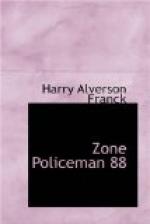Late one unoccupied afternoon I picked up the path behind the Administration Building and, skirting a Zone residence, began to climb that famous oblong mound that dominates the Pacific end of the landscape from every direction,—Ancon Hill. For a way a fairly steep and stony path lead through thick undergrowth. Then this ceased, and a far steeper trail zigzagged up the face of the bare mountain, covered only with thin dead grass. The setting sun cast its shadow obliquely across the summit when I reached it,—a long ridge, with groves of trees, running off abruptly toward the sea. On the opposite side Uncle Sam was cutting away a whole side of the hill. But the five o’clock whistle had blown, and whole armies of little workmen swarmed across all the landscape far below, and silence soon settled down save for the dredges at Balboa that chug on through the night. But for myself the hill was wholly unpeopled. A sturdy ocean breeze swept steadily across it. The sinking sun set the jungle afire in a spot that would have startled those who do not know that it rises in the Pacific at Panama, crude, glaring colors glowed, fading to gentler and more delicate tints, then the evening shadow that had climbed the hill with me spread like a great black veil over all the world.
But the moon nearing its full followed almost on the heels of the setting sun and, casting its half-day over a scene rich in nature and history, invited the eye to swing clear round the hazy circle. Below lay Panama dully rumbling with night traffic. Silent Ancon, still better lighted, cuddled upon the lower skirts of the hill itself. Then beyond, the curving bay, half seen, half guessed, with its long promontory dying away into the hazy moonlit distance, lighted up here and there by bush fires in the jungled hills. Some way out winked the cluster of lights that marked Las Sabanas. In front, the placid Pacific, the “South Sea” of the Spaniards, spread dimly away into the void of night, its several islands seen only by the darker darkness that marked where they lay.
On the other side of the hill the rumble of cranes and night labor came up from Balboa dock. There, began the canal, which the eye could follow away into the dim hilly inland distance—and come upon a great cluster of lights that was Corozal, then another group that was Miraflores, close followed by those of Pedro Miguel; and yet further, rising to such height as to be almost indistinguishable from the lower stars the lights of the negro cabins of upper Paraiso twinkled dimly above a broad glow that was Paraiso itself. There the vista ended. For at Paraiso the canal turns to the left for its plunge through Culebra hill, and all that follows,—Empire, Cascadas, and far Gatun, was visible only in the imagination.




